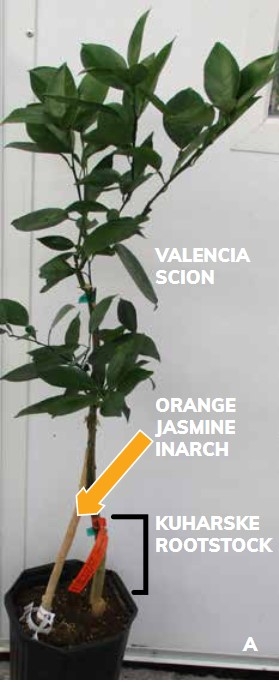A recent article in Citrograph recounts studies in introducing tolerance/resistance to huanglongbing by inarching. This is a method that could potentially improve the productivity of trees that are already in the ground. This technique would reduce the huge demand on the nursery industry to supply the volumes of replacement trees that will be necessary when the ultimate scion/rootstock combinations tolerant to HLB have been identified.
Chandrika Ramadugu, Thomas G. McCollum, Joseph Patt and Mikeal L. Roose
Inarched tree with ‘Kuharske' rootstock, ‘Valencia' scion and ‘Orange
jasmine' inarch. After challenging with two HLB-positive bark patches, the plants
inarched with ‘Orange jasmine' were without HLB symptoms (Ct for ‘CLas was 35-38)
for six months. When the inarch was dislodged due to excessive growth of ‘Orange
jasmine,' the CLas titer increased (Ct 24).
Inarching (a second rootstock grafted onto the citrus scion generating a composite plant with two root systems) resistant plants to susceptible citrus scions was useful for mitigation of citrus sudden death disease prevalent in Brazil. If a similar approach can diminish HLB symptoms, it may provide a short-term disease management strategy for infected trees. With help from Brite Leaf citrus nursery in Florida, we generated a setof grafted plants with ‘Kuharske' rootstock and ‘Valencia' scion. These plants were then inarched above the bud union with small, rooted seedlings of four different non-citrus taxa previously determined to be resistant/tolerant to HLB. We monitored CLas titer and symptom development in the scion for disease scoring. The four plants used for inarching were: ‘Eremolemon,' 'Australian finger lime,' 'Large leaf Australian wild lime' and ‘Orange jasmine.' 'Eremolemon,' a naturally occurring hybrid of ‘Australian desert lime' and ‘Meyer lemon,' is resistant to HLB; on a disease scale of1-8, with 1 being immune and 8 being most susceptible (scoring is based on Ctvalues and symptom expression), ‘Eremolemon' scored a 2, a resistant response.Since ‘Eremolemon' produces nucellar seedlings that are identical to the mother plant, the progeny has only HLB-resistant individuals. ‘Australian Finger lime' and ‘Large leaf Australian wild lime' were considered HLB-tolerant with a score of 3.Seedlings from open-pollinated Microcitrus species growing in the Givaudan CitrusVariety Collection (where citrus and Microcitrus are growing in close proximity),are expected to have variable HLB disease response. ‘Orange jasmine' is resistant to CLas and has a disease score of 2; all the seedlings in the progeny show HLB resistance.
The experiment consisted of 108 inarched plants evaluated for up to one year in three locations – a research field and a greenhouse in Fort Pierce, Florida,and an organic grove in Clermont,Florida. The inarched plants were challenged with bark patches from a CLas-positive plant in the greenhouse. In the field, exposure to CLas was via psyllid feeding. Composite grafted plants inarched with ‘Eremolemon,'‘Australian Finger lime' and ‘Large leaf Australian wild lime' developed HLB symptoms indicating that these HLB-resistant or tolerant accessions did not impart this trait to the grafted plant.However, ‘Orange jasmine' used as an inarch did offer protection against CLas if the inarched stem was securely attached to the grafted plant. Out of 22plants inarched with ‘Orange jasmine,'20 showed low titers of CLas (Ct 35-38) and did not develop symptoms when the inarch was intact. However, due to the difference in the growth rates of citrus and ‘Orange jasmine,' the inarch was dislodged after a few months. We have modified the technique and are continuing experiments to confirm the ability of ‘Orange jasmine' to impart disease tolerance.
Preliminary results indicate that HLB-resistant ‘Orange jasmine' can impart tolerance to scions grafted on ‘Kuhaske' rootstock.
